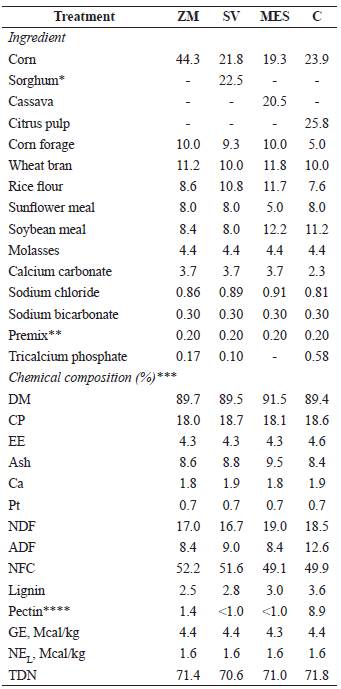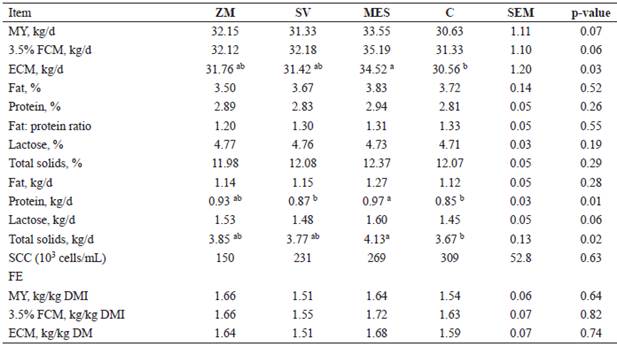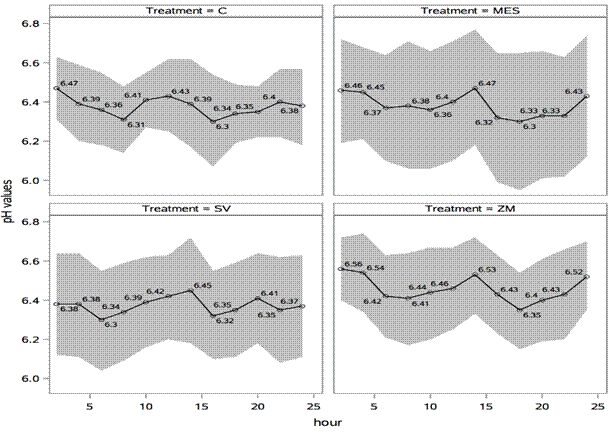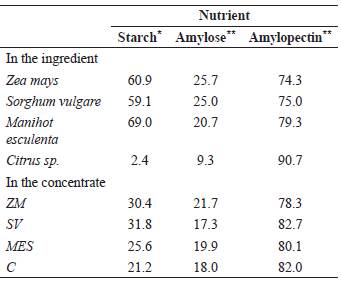Introduction
Kikuyu grass (Cenchrus clandestinus) is widely used in Colombia as grazing forage for dairy cattle. As a forage base, kikuyu has nutritional limitations, such as excessive protein and low energy contents, which commonly result in milk yields lower than 11 kg/cow/d (Marais, 2001). Accordingly, non-fibrous carbohydrates (NFC) content should be increased in the diet of lactating cows in order to improve energy availability in the rumen.
Corn (Zea mays) is the most widely used energy source in dairy feeds because it is rich in starch, representing 72% of the grain (Tabasum et al., 2018). Other NFC sources, such as sorghum (Sorghum vulgare), cassava (Manihot esculenta) and citrus pulp (derived from Citrus genus) are of interest because they do not compete with human food sources. In comparison to corn, starch content is similar in sorghum (Huntington et al., 2006), higher in cassava (84%; Santana and Meireles, 2014), and lower in citrus pulp (2.3%); although the latter has higher sugar (24.1%) and pectin (22.3%) concentration (Bampidis and Robinson, 2006).
Rapidly-fermenting carbohydrate sources improve MY and quality, but it can compromise animal health by increasing the risk of subacute ruminal acidosis (SARA). In pasture-based production systems typical of the Colombian high tropics forage is offered ad libitum and cows are fed a concentrate supplement twice-a- day during milking, which increases SARA risk.
Researchers have studied this disorder by inducing sudden changes in the diet of non- lactating animals (Li et al., 2012; Gao and Oba, 2016; Jing et al., 2018), but the effects on yield and milk composition remain unclear. Therefore, it is important to evaluate the effect of NFC-rich ingredients on SARA incidence and performance of lactating cows. Therefore, the objective of this study was to evaluate a partial replacement of corn grain in the ration with sorghum grain, cassava root, or citrus pulp on MY and quality, ruminal pH, and animal health of grazing Holstein cows.
Materials and Methods
Ethical Considerations
This study was approved by the Ethics Committee for Animal Experimentation at Universidad de Antioquia (act 76, May 2012, Medellin-Colombia).
Location, animals and experimental design
The experiment was conducted in Santa Rosa de Osos municipality (Antioquia, Colombia). Eight Holstein-Friesian cows averaging 534 ± 34 kg body weight (BW) were used in a 4 x 4 replicated Latin square design, resulting in 32 experimental observations. The calving number effect was considered in the experimental design, with third-calving cows assigned to the first square and those with fourth and fifth calvings to the second square. The study was conducted during the first 60 days (d) postpartum. The duration of each period was 15 d, with 10 d for adaptation and 5 d for the experimental period.
Experimental diets and feeding
Animals were managed under strip-grazing with kikuyu grass (Cenchrus clandestinus), allowing 41-d regrowth periods. The area of the grazing strips was adjusted daily, providing 31 kg DM/cow/d. Grass dry matter (DM) concentration was 13.1 ± 0.5% and its chemical composition (as DM%) was as follows: CP: 24.7 ± 1.6%, ether extract (EE): 3.7 ± 0.6%, neutral detergent fiber (NDF): 52.9 ± 3.9%, acid detergent fiber (ADF): 29.8 ± 2.4%, lignin: 4.6 ± 0.5%, ash: 9.6 ± 1.0%, and NFC: 9.1 ± 0.9%. Nitrate concentration (NO3) was 2,224.7 ppm. Energy density was 1.34 ± 0.08 Mcal net energy for lactation (NEL)/kg DM.
Concentrate offer was based on weekly MY in a ratio close to 1:3.5 (1 kg concentrate per 3.5 kg milk). Four isoenergetic and isoprotein concentrates, corresponding to the experimental treatments, were compared. The Zea mays (ZM) treatment included corn grain as the main source of energy. In the remaining treatments, 50% approximately of the total digestible nutrients (TDN) contributed by corn were provided by sorghum grain (Sorgum vulgare: SV), cassava root (Manihot esculenta: MES), or dehydrated citrus pulp (Citrus sp.: C) (Table 1 and 2). Concentrates were offered twice-a-day during milking, at 04:00 and 14:00 h.
Chemical description of feed
Samples were analyzed for DM, CP, EE, ash, α-amilase NDF, ADF, Ca, P (AOAC, 2005; AOAC, 2007), lignin (Van Soest and Wine, 1968), gross energy (GE) (ISO, 1998), pectin (Hansen et al., 2001), starch (AOAC, 2000), amylose and amylopectin (Yun and Matheson, 1990). TDN and NEL were estimated with the model proposed by the NRC (2001). Condensed tannin content in sorghum grain was analyzed with the technique described by Dykes (2019). NO3 in kikuyu was determined with photocolorimetry as described by Spörndly et al. (2016).
Dry matter intake
Total dry matter intake (DMIT) corresponds to dry matter intake from pasture (DMIP) and concentrate (DMIC). The DMIC was calculated by difference between the feed offered and rejected.
Chromium oxide was used as an external marker, and indigestible dry matter (IDM) was the internal marker (Correa et al., 2009) to determine DMIp.
Milk yield and quality
Milk from the morning and afternoon milkings was weighed daily during the last three days of each experimental period (MM27BC automatic system, DeLaval International AB, Tumba, Stockholm, Sweden). The MY was corrected to 3.5% fat (3.5% FCM) and also for energy (ECM) (Boerman et al., 2015). To evaluate milk quality, separate samples from morning and afternoon milkings were collected from each animal. A MilkoScan FT+ (Fourier Transform from Infrared; Foss, Hillerød, Denmark) was used to analyze samples for protein, fat, lactose, and total solids content (%). Somatic cell count (SCC; cells/mL) was assessed by flow cytometry (Fossomatic™ FC, Foss Electric, Hillerød, Denmark). Feed efficiency (FE), calculated from MY and DMIT.
Table 1 Ingredients and chemical composition of the concentrates.

Zea mays (ZM), Sorghum vulgare (SV), Manihot esculenta (MES), and Citrus sp. (C).
* Sorghum with 954.5 mg catechins/100g sample.
** Composition per kg of premix: 2,500,000 IU of vitamin A; 750,000 IU of Vitamin D3; 2,000 IU of Vitamin E; 12.5 g of Fe; 2.5 g of Cu; 10 g of Mn; 10 g of Zn; 0.15 g of I; 0.025 g of Co; 30 g of antioxidant (BHT).
***Expressed in 100% dry matter (DM): CP, crude protein; EE, ether extract; Ca, calcium; Pt, total phosphorus; NDF, neutral detergent fiber; ADF, acid detergent fiber; NFC, non-fibrous carbohydrates; GE, gross energy; NEL, net energy for lactation; TDN, total digestible nutrients.
Ruminal pH, rectal temperature and locomotion score
Ruminal pH was measured in the last 3 d of each experimental period using intraruminal boluses (eCow Ltd, Exeter, Devon, UK) (Mottram et al., 2008). The pH was measured every 60 seconds, taking average values every 15 minutes. The average, minimum, and maximum ruminal pH values were determined for 24-h periods. Rectal temperature was measured on the last 3 d of each period at 09:00 and 15:00 h, and data were averaged per day. Locomotion score (LS) was assessed using a 1 to 5 scale (Sprecher et al., 1997) on the last day of each period. The animals were weighed on day 11 of each experimental period, and body condition score (BCS) was evaluated simultaneously.
Hematology, blood chemistry, and milk urea nitrogen
Blood samples were collected from the coccygeal vein on the 15th d of each period (at 09:00 h). Parameters evaluated were: red blood cells (RBC), hemoglobin (Hb), hematocrit (HCT), mean corpuscular volume (MCV), mean corpuscular hemoglobin (MCH), mean corpuscular hemoglobin concentration (MCHC), platelets (PLT), plateletcrit (PCT), mean platelet volume (MPV), platelet distribution width (PDW), white blood cells (WBC), and WBC differential (neu- trophils, lymphocytes, monocytes, eosinophils, neutrophil: lymphocytes ratio) (Cell-Dyn system 3500 automated hematology analyzer; Abbott Laboratories, Abbott Park, IL, USA). Blood chemistry analysis included urea, creatinine, gamma glutamyl transferase (GGT), alkaline phosphatase (ALP), Ca, P, Mg, total plasma proteins (TPP), albumin (ALB) and globulins (GLOB) (Vitros 250 Chemistry Analyzer, Ortho- Clinical Diagnostics, Markham, ON, Canada). Likewise, milk urea nitrogen (MUN) was deter- mined with a MilkoScan FT+ (Fourier transform infrared; Foss, Hillerød, Denmark) using the same samples analyzed for quality.
Statistical analysis
Response variables were analyzed under a 4x4 replicated Latin square design using the MIXED procedure in SAS/STAT® 14.1 software (SAS, 2015). A subsampling design was used to analyze rectal temperature and pH (Zamudio-Sanchez and Alvarado-Segura, 1996). Significant differences were declared at p<0.05, and a tendency was declared at 0.05≤p≤0.10. The BCS and LS were evaluated with Friedman's two-dimensional ANOVA by ranges for related samples (5% statistical significance).
Results
Table 3 presents BW, BCS, DMI and forage: concentrate ratio (F:C ratio). No statistical difference was observed between treatments (p>0.05). MY, 3.5% FCM, and lactose tended to differ (p<0.10) with highest and lowest values for MES and C, respectively, which differed (p<0.05) in ECM, protein, and total solids in favor of MES. Protein was also different (p<0.05) between MES and SV (Table 4).
Table 5 presents the effect of treatment on ruminal pH, rectal temperature, and LS. No differences were found between treatments (p>0.05).
The pH dynamics is shown in Figure 1.
Table 3 Body weight (BW), body condition score (BCS), dry matter intake (DMI), and forage: concentrate ratio (F:C ratio) of lactating cows supplemented with different carbohydrate sources.

Treatments: Zea mays (ZM), Sorghum vulgare (SV), Manihot esculenta (MES), and Citrus sp. (C).
BW, body weight; BCS, body condition score; DMIP, DMIC and DMIT, pasture, concentrate and total dry matter intake; F:C ratio, forage:concentrate; NDF, neutral detergent fiber; NFC, non-fiber carbohydrates.
SEM, Standard error of the mean.
Hematological parameters (Table 6) showed no differences between treatments (p>0.05).
Metabolic profile (Table 7) showed no differences between treatments (p>0.05).
Discussion
The chemical composition of kikuyu fits the values described by Correa et al. (2008). Despite different starch levels (Table 2), our concentrates were not different in NFC because citrus pulp is rich in sugar and pectin (Bampidis and Robinson, 2006).
No decrease in ruminal pH was found (Table 5), which explains the similar DMIT, DMIP, and DMIC observed between treatments (Table 3). The absence of ruminal acidosis could be due to the intake of NDF and NFC, and the F:C ratio, close to the 60:40 recommended in the literature (Mertens, 2009). Total NDF intake represented 38.5, 37.9, 39.4, and 38.6% of DMIT for treatments ZM, SV, MES and C, respectively, while NDF consumption from forage was 31.6, 31.0, 31.9, and 30.9% of DMIT, correspondingly. Therefore, NDF from forage fluctuated between 80.0 and 82.2% of total NDF intake. According to Mertens (1997), ruminant diets must contain at least 25% NDF, 76% from forage. Krause and Oetzel (2006) suggest restricting NFC to 35- 40% of DMIT to prevent SARA. In our study, NFC intake represented 26.4, 26.7, 25.0, and 26.1% of the DMIT for ZM, SV, MES and C, respectively. In conclusion, the lack of difference in DMI between treatments reflects its similarity in nutritional characteristics without adversely affecting ruminal fermentation conditions.
Table 4 Effect of carbohydrate source on yield and quality of milk, and feed efficiency.

Treatments: Zea mays (ZM), Sorghum vulgare (SV), Manihot esculenta (MES), and Citrus sp. (C).
MY, milk yield; 3.5% FCM, 3.5% fat-corrected milk; ECM, energy-corrected milk; SCC, somatic cell count; FE, feed efficiency; DMI, dry matter intake.
SEM, Standard error of the mean.
Treatment means with different letters (a, b) within the same row differ significantly (p<0.05).
Table 5 Rumen pH, rectal temperature and locomotion score (LS) of lactating cows supplemented with different carbohydrate sources.

Treatments: Zea mays (ZM), Sorghum vulgare (SV), Manihot esculenta (MES), and Citrus sp. (C). SEM, Standard error of the mean.

Figure 1 pH dynamics of lactating cows supplemented with different carbohydrate sources (Treatments: Zea mays (ZM), Sorghum vulgare (SV), Manihot esculenta (ME), and Citrus sp. (C)). The solid line represents the average pH obtained at 2-hour intervals. The gray shadow represents the standard deviation of the observations.
Performance differences between MES and C (Table 4) can be caused by differences in the ruminal degradation rate of carbohydrates and fermentation profile. Santos-Silva et al. (2016) suggested that pectin can interfere with ruminal fermentation because of its slightly lower rate and extent of degradation when compared to starch. According to Gómez et al. (2016), higher digestibility of cassava starch vs. starch from corn and sorghum is due to the lack of pericarp and protein matrix, less protein-starch association, lower proportion of corneous endosperm, lipids and amylose. Pectin increases the acetate molar proportion and reduces propionate molar proportion (Bampidis and Robinson, 2006). In contrast, starch fermentation tends to increase the propionate molar proportion (Ørskov, 1986), which is associated with an increase in glucose supply and MY (Khalili and Sairenen, 2000).
The greater milk protein and solids in MES vs. C resulted from greater MY and, to a lesser extent, a slight increase in their concentration (Table 4). Theurer et al. (1999) found increased MY and milk protein from greater ruminal digestion of starch. Lower milk protein in SV vs. MES (Table 4) can be explained by its lower starch fermentation (Offner et al., 2003) and high tannin content. Adetunji et al. (2013) reported catechins concentrations ranging between 0.09-0.33% in tannin-free sorghum and 0.37-1.34% in tannin sorghum. Sorghum catechins concentration in this study was 0.95%.
According with milk fat results (Table 4) none of the treatments had a negative effect on ruminal pH or fiber digestibility. The fat:protein ratio (F/P; Table 4) was within the optimal range (1.2 to 1.4) reported by Čejna and Chládek (2005), again, confirming SARA absence (G/P<1.2).
Table 6 Hematological parameters of lactating cows supplemented with different carbohydrate sources.

Treatments: Zea mays (ZM), Sorghum vulgare (SV), Manihot esculenta (MES), and Citrus sp. (C).
RBC, red blood cells; Hb, hemoglobin; HCT, hematocrit; MCV; mean corpuscular volume; MCH, mean corpuscular hemoglobin; MCHC, mean corpuscular hemoglobin concentration; PLT, platelets; PCT, plateletcrit; MPV, mean platelet volume; PDW, platelet distribution width; WBC, white blood cells.
SEM, Standard error of the mean.
The SCC values were below the limit (400 × 103 cells/mL) set in Europe, New Zealand and Australia (Sharma et al., 2011).
Under optimum conditions, FE should fluctuate between 1.4 and 1.8 kg of 3.5% FCM per kg DMI (Hutjens, 2005), which is in line with our results (Table 4).
Once more, our results confirm the absence of SARA. It is also known that acidosis increases the heat produced per unit of digestible energy, resulting in lower net energy available for production (Casper and Mertens, 2007). SARA occurs when ruminal pH lower than 5.5 to 5.8 persists for several hours a day (Danscher et al., 2015). According to this, none of our treatments resulted in SARA (Table 5; Figure 1). Other factors, besides those discussed (F:C ratio, NDF and NFC consumption), can explain the absence of SARA in this work, namely, dietary CP and forage NO3. Based on BW, MY and DMIT, dietary CP should have been 15.6% to meet NRC (1988) requirements. However, it was 22.1 ± 0.08%, with 66.2 ± 1.3% from kikuyu. It is known that more than 30% of kikuyu CP is rapidly and completely degraded in the rumen (Correa et al., 2008). High CP degradation releases ammonia, which captures protons (H+) due to its pKa (9.2 dissociation constant) increasing pH (Bates and Pinching, 1949), which explains the buffer effect of CP in the present experiment. In our study, NO3 in kikuyu was between the range reported by Correa et al. (2008). As an electron acceptor, NO3 is reduced to NH + (Leng, 2008), buffering the ruminal pH. Acidosis leads to gram-negative bacteria lysis, increasing lipopolysaccharide, which passes from rumen to blood causing fever, hypoperfusion of hoof capillaries, and laminitis (Kleen et al., 2003). No evident alterations in LS or rectal temperature were observed in our study, confirming once more the absence of SARA.
Table 7 Metabolic profile of lactating cows supplemented with different carbohydrate sources.

Treatments: Zea mays (ZM), Sorghum vulgare (SV), Manihot esculenta (MES), and Citrus sp. (C).
GGT, gamma glutamyl transferase; ALP, alkaline phosphatase; Ca, calcium; P, phosphorus; Mg, magnesium; TPP, total plasma proteins; ALB, albumin; GLOB, globulins; FBG, fibrinogen; MUN, milk urea nitrogen.
SEM, Standard error of the mean.
Hematological parameters and metabolic profile were within reference values (Coroian et al., 2017; Botezatu et al., 2014; Radkowska et al., 2014), with the exception of MUN (Table 7). Optimal MUN in lactating cows fluctuates between 7 and 12 mg/dL (Hulsen et al., 2014), markedly lower than that observed in this work. As previously stated, CP consumption exceeded NRC (1988) requirement, and NFC was below the limit described by Krause and Oetzel (2006).
In conclusion, partial substitution of corn grain by sorghum grain, cassava root, or citrus pulp did not affect rumen pH, DMI, or FE. Cows had a high intake of CP and NDF, while NFC intake was lower than that reported in the literature. These dietary characteristics protected the cows against SARA. The higher availability of energy from cassava increased MY, protein and total solids, contrary to the effect of citrus pulp inclusion.















